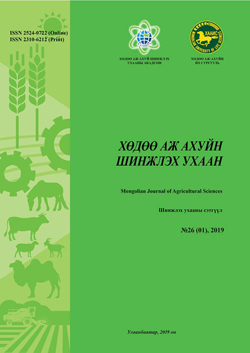Weed study of mulched field in soil conservation technology
DOI:
https://doi.org/10.5564/mjas.v26i01.1204Keywords:
Straw mulching, soil moisture, soil temperature, yieldAbstract
Global climate change has been increasing year by year, and this change has become more intense in our country. According to a study published by the Institute of Meteorology, Hydrology and Environmental Research, the temperature has risen by 1.56 degrees over the last 60 years, with the change expected to rise by 1.99 degrees by 2020 and by 3.13 degrees by 2050. Mongolia has an extreme continental climate, and its’ plant cover is loose, soil humus layer is thinner, has mainly light mechanically compounded soil, low precipitation in winter, dryness in spring. On the other hand, using a short rotation of grain fallow has created agro-ecological conditions such as vulnerable and a poorly-recovered environment. Under this situation, crop technologies need to be adapted to mitigate these negative consequences of the climate. Creating a large amount of plant covering will protect the soil from direct sunlight and its consequences. The final result of our research work is focused on identifying the changes of soil moisture regime of the covered area furthermore, the positive and negative impacts on the soil, decrease of weeds. As a result of covering the soil surface with straw, temperature reduced by 2 degrees during the planting season, weeds grew 3.4 times less, the moisture of soil increased by 5.5 mm and plantlet of wheat seeds increased by 6.2 percent respectively. As an average of study years weed quantity at mulched variants was less by 14 pc/m2 and less weight 7.1 g/m2 than mulch less variants, this was increased weight of the main crop by 36.6 g/m2 and yield by 1.8 t/ha, respectively.
Хөрс хамгаалах хучлагатай тариалангийн технологийн хог ургамлын судалгааны дүн
Хураангуй: Дэлхийн хэмжээнд уур амьсгалын өөрчлөлт эрчимжиж, жилээс жилд дулаарал нэмэгдэж, энэхүү өөрчлөлт нь манай орны нөхцөлд бага хугацаанд илүү хүчтэй мэдрэгдэх боллоо. Ус цаг уур, орчны судалгаа, мэдээллийн хүрээлэнгээс гаргасан судалгаагаар сүүлийн 60 жилийн хугацаанд агаарын температур 1.56 хэмээр нэмэгдсэн, энэхүү өөрчлөлт цаашид үргэлжлэх ба 2020 он гэхэд 1.99 хэм, 2050 онд 3.13 хэмээр нэмэгдэх төлөвтэй байгааг судлаачид тогтоосон байна. Дулаарал нэмэгдэхийн хэрээр хөрсний чийгийн ууршилт нэмэгдэж, бэлчээрийн болон таримал ургамлын чийг хангамж дутагдах, хур тунадасны хүртээмж буурах нь зайлшгүй болно. Хур тунадас багатай, чийг хангалтгүй үед тариалангийн технологи нь уур амьсгалын энэхүү сөрөг үр дагаварт дасан зохицсон, нөлөөллийг нь бууруулахад чиглэх шаардлагатай бөгөөд бидний судалгааны үр дүн нь тариалангийн талбайд ургамлын нөмрөг үүсгэснээр хөрсийг халалт цонолтоос хамгаалах, хучлага бүхий талбайн хөрсний чийг дулааны горимын өөрчлөлт, сүрлэн хучлага хог ургамалд хэрхэн нөлөөлж буйг илрүүлэв. Тариалангийн талбайн хөрсний гадаргууд 3 т сүрлэн хучлага үүсгэснээр хавар тарилтын үед хөрсний үр суух гүний дулааныг 2 хэмээр бууруулж, хөрсний өнгөн 0-50 см гүний чийгийг 5.5 мм-ээр нэмэгдүүлснээр буудайн үрийн соёололтыг 6.2 %-иар нэмэгдүүлж, хог ургамал 3.4 дахин бага ургажээ. Хучлагатай талбайн цэцэглэлтийн үеийн хог ургамал 14 ш/м2-ээр, хог ургамлын жин 7.1 г/м2 -аар хучлагагүй хувилбараас бага байхад үндсэн таримлын жин нь 36.6 г/м2-аар их байгаа нь 1.8 ц/га-аар ургацыг нэмэгдүүлэв.
Түлхүүр үг: Сүрлэн хучлага,чийг, дулаан, ургац
Downloads
684
Downloads
Published
How to Cite
Issue
Section
License
Copyright on any research article in the Mongolian Journal of Agricultural Sciences is retained by the author(s).
The authors grant the Mongolian Journal of Agricultural Sciences a license to publish the article and identify itself as the original publisher.

Articles in the Mongolian Journal of Agricultural Sciences are Open Access articles published under a Creative Commons Attribution 4.0 International License CC BY.
This license permits use, distribution and reproduction in any medium, provided the original work is properly cited.




